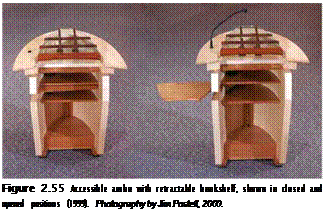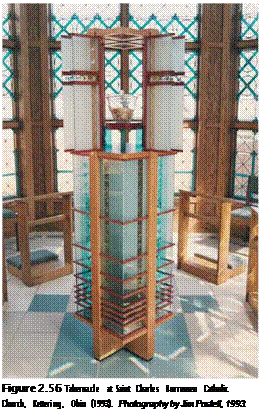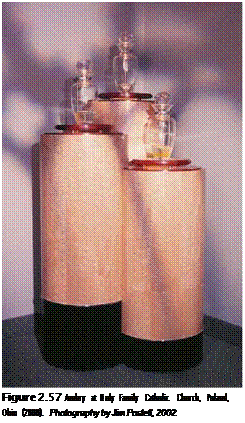Religious environments and the practice of unique rituals require specific furnishings. Liturgical furniture is determined by collective ritual practices that help structure how a given set of people worship together. A summary has been drawn up of the similarities and differences among three major religions as experienced in Catholic, Jewish, and Islamic places of worship.
Catholic Church Furnishings
The altar, ambo, ambry, cantor stand, credence table, gift table, ossuary, presider’s chair, processional cross, and tabernacle are standard liturgical furnishings within a Catholic church.10 These furnishings are typically conceived as a suite. Liturgical guidelines for the Catholic furnishings illustrated in this section were based upon Environment and Art in Catholic Worship, published by the National Conference of Catholic
Bishops (1978).
The altar is a focal point for the celebration of the mass. It is located in the midst of the people who gather to receive the Eucharist. The form and location of the altar shown in Figure 2.54 maintain its liturgical focus and accessible ideal position in space.
Originally, the ambo was conceived as a raised platform located in the nave of Greek Orthodox churches, marking the place to stand and read the Gospel or the Epistle.11 Today, it is comparable to the altar in the liturgical setting since the first part of the liturgy centers on the word of God. In recent years, accessibility has become increasingly important in liturgical furnishings. The ambo shown in Figure 2.55 responds to the challenge of incorporating accessible and universal design directives in new liturgical furnishings.
The Eucharistic chapel is a unique space in a Catholic church, which houses the tabernacle and sacramental candle. The Eucharistic chapel can be spatially partitioned by an iconostasis screen from the assembly area. The sacramental candle is located close to the tabernacle and is always lit (using a seven – or eight-day candle) and serves as a sign that Christ is present. The tabernacle contains a ciborium (a container for the bread used in the mass) and host. Though traditionally opaque, the tabernacle for Saint Charles Borromeo Catholic Church in Kettering,
 Ohio, displays the ciborium through its tempered glass and cherry wood frame (Figure 2.56). In addition to the celebration of the liturgy, people may be invited to vigil in the Eucharistic chapel for private silent prayer. For these occasions, prie-dieux kneelers are used.
Ohio, displays the ciborium through its tempered glass and cherry wood frame (Figure 2.56). In addition to the celebration of the liturgy, people may be invited to vigil in the Eucharistic chapel for private silent prayer. For these occasions, prie-dieux kneelers are used.
Holy oils are among the most highly revered sacramentals of the Catholic Church and are stored in an ambry. Recently, the holy oils have become more visibly prominent in the Catholic Church. The ambry shown in Figure 2.57 displays and secures the holy oils and is located close to the baptismal font.
 |
 |
Baptismal fonts are liturgical furnishings that are either portable or physically incorporated into the architecture. They are often located near the entry, in a gathering area, or placed on the sacramental platform along with the altar and ambo. They are used periodically and serve an important function in the church.
 Synagogues
Synagogues
Reform and Orthodox Jewish synagogues are liturgically similar, as are their furnishings. The ark is the most important liturgical furniture in a synagogue. It refers to the Ark of the Covenant, where the word of God was kept safe during the time of Moses. The ark is also called the Crown of the Torah.12 Freestanding and built-in arks (Figure 2.58) contain Torah scrolls and are located close to the ner tamid (all-burning light). The interior of the ark is illuminated and often screened (by a veil or glass) so that the Torah scrolls are not visually prominent during the service.
The Torah table usually has a canted surface in order to read the Torah. The size of the Torah table is generally large enough to accommodate a Torah scroll and up to four people gathered around it. A reading table or lectern is used for reading a book, singing, or speaking. Liturgical pieces are located on the bima (a raised platform). The bima spatially defines the functions of worship and indirectly guides the layout of the assembly seating for regular services and High Holy Days (Figure 2.59).



